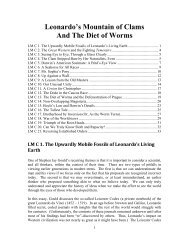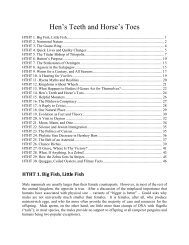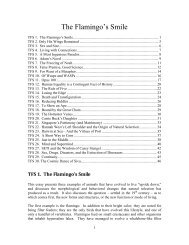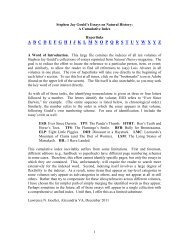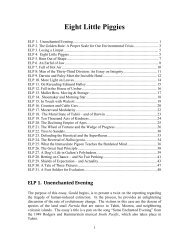Dinosaur In a Haystack - A Website About Stephen Jay Gould's ...
Dinosaur In a Haystack - A Website About Stephen Jay Gould's ...
Dinosaur In a Haystack - A Website About Stephen Jay Gould's ...
Create successful ePaper yourself
Turn your PDF publications into a flip-book with our unique Google optimized e-Paper software.
One might argue, without great exaggeration, that 530 million years of subsequentevolution has produced no more than a set of variations upon the themesestablished during this initial explosion – although some of these little fillips,including human consciousness and insect flight, had quite an impact upon thehistory of life!Many scientists, including Darwin himself, did not and do not share Gould’s view thatthe Cambrian explosion was distinct from “business as usual,” and thus in need of its ownexplanation. Darwin argued that the apparent suddenness was probably an artifact of animperfect fossil record. As time went by, additional evidence demolished this argument;however, those whose worldviews prefer a more stately and progressive view ofevolution [Gould uses these sorts of terms regularly] fell back on other lines of reasoningto imply that the explosion was not a completely unique event. One tack uses theargument that the “explosion” still required 30-40 million years, and thus likely involvesonly a speeded-up version of an ongoing process. [Gould counters that the evidencediscussed in the previous essay undermines this view, by limiting the duration of theevent to “only” five million years.] Another, perhaps more important line of reasoning isthat many of the so-called “minor phyla” – those with only a small number of livingspecies – arose significantly later. If upheld, this view would establish that phylumcreationis an ongoing process, rather than a unique event.Three phyla in particular are commonly referenced by supporters of this view as havingrelatively recent origins: Pentastomida (tongue worms), Onychophora (velvet worms),and Tardigrada (water bears). All three of these groups bear many important similaritiesto arthropods. Further, if one accepts the “increasing cone of diversity” paradigm innatural history [which Gould does not; see ELP 15], then the small number of livingspecies in each of these phyla (less than one hundred in all three cases) is consistent withthe notion that these phyla are all young, and thus have not had as much time to diversifyas the more ancient phyla. This is plausible, Gould concedes, but is it true? This essaydiscusses evidence, some published in the year he wrote it, that all three phyla can nowbe dated back to the Cambrian period.Velvet worms (onychophorans) superficially resemble caterpillars, and the 80 or so livingspecies all live on land, which was uninhabited during the Cambrian period. Thediscovery in the early 20 th century of one organism from the middle-Cambrian Burgessshale, Aysheaia, appeared to be in this phylum, but there was room for doubt. Morerecently, however, several other species of Onychophoran fossils have appeared inCambrian strata, including the famous Hallucigenia [ELP 24]. While undoubtedlyrelated to arthropods, it is now generally accepted that the branching between thesegroups took place long ago, and that this group does not represent a good example for theprocess of ongoing phylum creation.Tardigrada, or water bears, are sub-millimeter-sized animals, most of which live in filmsof water on mosses and other vegetation. They are renowned for being able to godormant in the absence of water and survive for decades in hostile conditions, thenreanimate themselves when the water returns. They also resemble arthropods in several11




